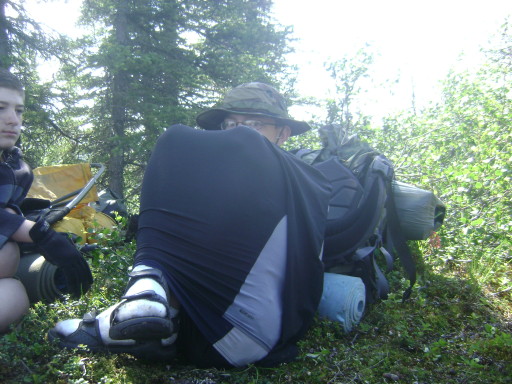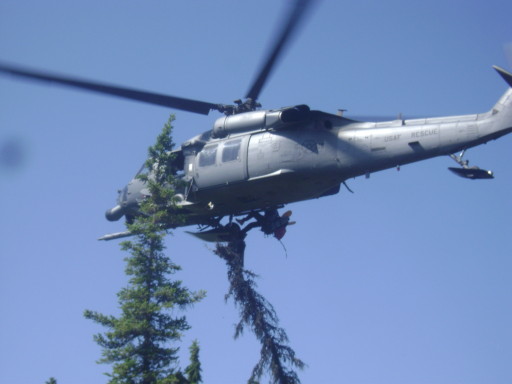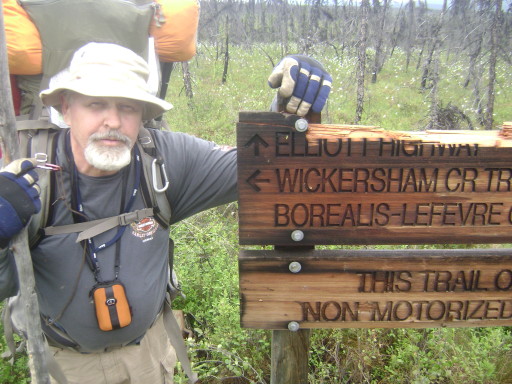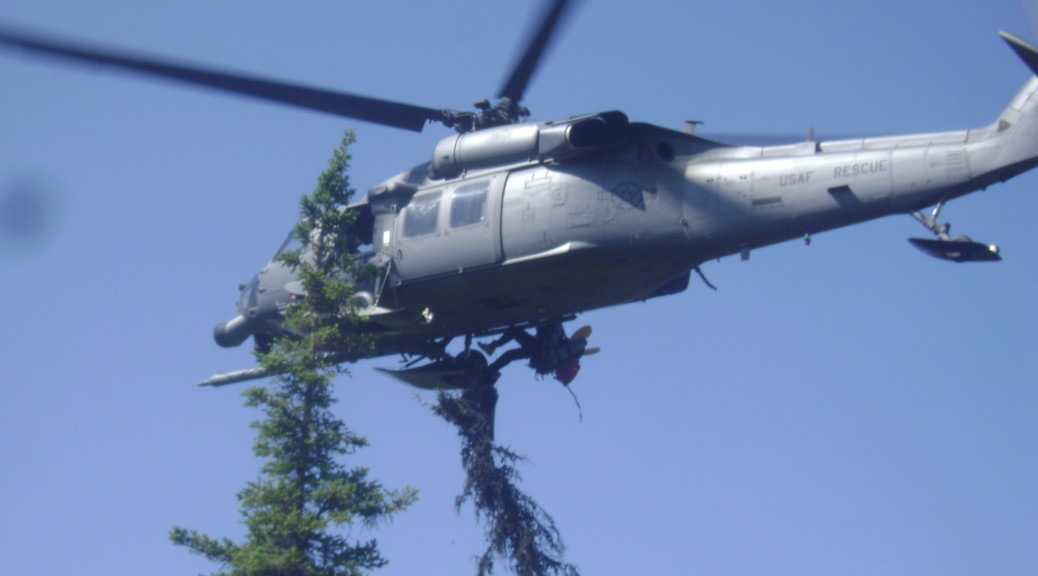One of my kids’ favorite activities when we have new visitors over for dinner is to try and get me telling stories. I’ve told many of these stories so many times that the kids like to start to tell them on their own if I don’t comply with their requests. I imagine some of these stories are among the things they will take with them long after I am gone, but to ensure that they are correct (according to my flawed memory), I’ve decided to write several of the more popular ones down. These stories are true to the best of my ability to remember them. It’s possible that some of the memories have been contaminated or that my role in them has been exaggerated, but any of these types of artifacts are purely unintentional. Unfortunately, some of the names are gone from me forever, so if I leave one out, it’s either out of respect or simply because I can’t remember anymore.
Alaskan Rescue
While we were in Alaska, I was called to work with the young men in my church as a counselor in the presidency that presided over them. When I was called to serve in this capacity, the scout master and young men had already planned their high adventure for the summer and were in the final stages of preparations. They had made arrangements to rent one-man “pack rafts” to float twenty miles down Beaver Creek north of Fairbanks, then roll up the rafts, strap them to their packs, and hike another forty miles along a trail through a protected state natural area.
To save money, the group had solicited donations of old dehydrated “food storage” items that they put together to make their own meals rather than spend the money required to purchase commercially prepared foods. Additionally, because of the weight of the raft-laden packs, they relied on availability of water along the trail and a single 20 oz filtering water bottle each for hydration. All of these arrangements had been made before I became involved in any form or fashion. By the time I showed up to the first meeting, they were testing their rafts and doing final bag-checks with the scoutmaster. I immediately began to have serious concerns.
I have experienced both that region of the Alaskan bush and the rigors of 50+ mile backpacking trips. One of the remote instrumentation locations we maintained for my work happened to be only a few miles off of the trail these young men would have to hike on their last two days. The trail crossed territory that can be extraordinarily challenging for grown and experienced men on high-end all-terrain vehicles equipped specifically for working in that environment. On one of many trips I made through that region, our maintenance team took almost seven hours to get four ATVs through a two-mile swamp. Other trips went somewhat faster, but all were very challenging due to a combination of crotch-deep muskeg (rotting peat-moss, water, and mud that has the consistency of warm Jello), narrow trails, fallen trees, and black swarms of mosquitoes nearly capable of picking you up and carrying you away.
To add to my concern over what I felt was an aggressive schedule in an unforgiving environment, I doubted how well prepared these young men were. We were a fairly small congregation, so to ensure they had enough people for the trip they had extended it to a younger crowd than normal. Three of the boys were just barely eligible and weren’t particularly physically strong. I worried that they would have difficulty carrying the load for the duration of this long trek. The scoutmaster (Mike Galloway) was near sixty, and appeared to be trying to compensate for the boys abilities by carrying extra stuff himself.
Mike was an experienced outdoorsman from the lower-48, but he was new to Alaska and hadn’t yet learned how actively Alaska tries to kill you. He knew a lot, but still had something to learn about just how intense it can get when things go sideways out in the bush. After some previously serious learning experiences myself, I was worried about him running into a similar situation with a bunch of boys in tow and not having the right kind of kit and training to get out of it.
I also had concerns about what it was they were taking. I doubted the wisdom in their creating their own meals from old food-storage, and pulled several of them aside to talk to them about what was in their packs when I showed up for the final bag-check. Some had pounds of extra crap… heavy tarps where lightweight plastic sheeting would suffice, redundant tools (hatchets, saws, tarps, etc…), heavy ponchos instead of a stash of general-purpose large garbage bags, etc… They were not particularly space/weight conscious. I made recommendations for how to reduce weight and better prepare for the bugs, mud, and terrain they were going to encounter, but they were cock-sure they were strong-enough and their packs were light enough that it wouldn’t be a problem. My final admonition was to assure them their toothbrush would feel heavy after a week and fifty miles, at which point I left them to the leaders who had prepared them.
The new young-men’s president (Josh Starr) and I did manage one concession though. He had purchased a SPOT beacon and subscription, and we were able to mandate they take it with them and use it to check in at the beginning and end of each day on the trail. This particular beacon was equipped with three buttons: one to send a preprogrammed message (“We’re doing fine” in this case), one to let us know they really needed help but weren’t at imminent risk to life or limb, and one to tell us to call the rescue helicopter because someone was going to bleed out soon. Button one was to be used several times daily as long as things were okay. Button two, they were told, would result in us launching a ground-based rescue party and they could expect us to show up within 8-24 hours depending on where they were. Button three, reserved for dire emergencies, would result in us calling in either the State Trooper’s helicopter or the Air National Guard PAVE HAWK that stood alert down the runway from my office.
The next Monday, we dropped them off at the put-in point on the river, not expecting to see them again until Saturday morning at the trail-head fifty miles away. The next few days were miserably cold and rainy, and aside from finding out that one of the boys had left his hiking boots at home and was on the trial with nothing more than a pair of sandals, we had little to worry about. Every day the SPOT beacon checked in, and we were even able to log into the SPOT website to track their progress. They were moving somewhat slowly, but making progress up until Thursday night.
 This poor young man forgot his boots and some of his warm clothes.
This poor young man forgot his boots and some of his warm clothes.
By Thursday mid-day, they had fallen roughly ten miles behind schedule, and by the end of the day had made almost no progress compared to where they were at lunch. Then, Friday morning, I got a call from Josh. He had received an e-mail from the beacon indicating that someone had pressed “button #2” twenty five miles or so from the trail-head. He wasn’t sure what to do, and was asking for my advice. Because I had a crew of people who were familiar with that area, had access to a wide range of high-end equipment, had survival training, high-level first aid kits and training, and were generally well suited to the task, I offered to take this one on and head up a rescue party.
While my guys started loading the trucks and trailers to head for the trail-head and were coordinating with the BLM representatives to get permission to use ATVs on the foot trails, I called my friend Matt “Harp” Harper at the rescue detachment down the runway. We often used them to get equipment and people to some of our more inaccessible locations when they weren’t otherwise busy, and we had a good working relationship with the commander and aircrew. I explained what had happened, the limited information we had, and asked him what he thought. A few minutes later, I was on the phone with the Rescue Coordination Center (RCC) in anchorage who informed me we’d probably have to go in on the ground, but told me they would call if something changed.
Right as we were pulling out of the parking lot to start the trek, I got a call from the pilot informing me they were turning rotors in five minutes, would be on-site in thirty, and back home within an hour. Apparently the crew was bored and wanted something to do before they had to get the aircraft ready to fly it back to Anchorage that afternoon. They argued that if we got there on foot and found out it was bad enough we wouldn’t be able to get them out that way, they would have already left and another crew would have to fly a helicopter all the way up from Anchorage. Rescuing an injured hiker, they argued, was better training for their primary job (aircrew recovery) than hauling cargo around the training ranges. Their argument, combined with some confusion at the RCC about who it was that was injured (I said “scouts,” and they assumed I had a military team out in the bush instead of a bunch of kids ). By the time we cleared up the misunderstanding, the helicopter was airborne, so they whitewashed it as a training sortie. I checked my watch to know when I needed to head to the hangar, we turned around, and began to unload all the gear.
 George Patterson being hoisted into the AKANG PAVE HAWK
George Patterson being hoisted into the AKANG PAVE HAWK
Apparently, their estimation of how long it would take was off by about twenty minutes. As I pulled into the hangar parking lot, a truck passed by me on the way out. I didn’t pay much attention to it and walked into the hanger to find the helicopter had already landed and everyone but the pararescue jumper was gone. In our brief interview, he told me one of the kids (George) had busted his knee up and couldn’t walk but was otherwise okay, that they had texted his father (the leader of our congregation and head doc at the clinic on base) that George was on the helicopter headed to the hospital and to meet him there, realized his father was in Anchorage for a meeting, and texted his mother to meet him instead. Apparently it didn’t dawn on them how frightening it would be for a parent to get a text telling them their oldest son was on a rescue helicopter headed for the hospital when he was supposed to be in the wilderness camping. The truck I had passed in the parking lot was the aircrew taking George over to the clinic.
Thankfully, George lived about twenty minutes from the base, so I was able to go over to the clinic and intercept Sonya (his mom) when she stormed through the door in a panic, reassure her George was okay, and make sure everything was taken care of. I didn’t get a chance to talk to George, but I was told he had a smile on his face for a solid week after the helicopter ride. After a few weeks in a brace, he was by all appearances back to normal.
The next morning, we were supposed to meet the boys at the trail-head around ten o’clock. Because they were twenty five miles in when the helicopter rescue took place, I was pretty sure they weren’t going to be able to cover that distance to make the scheduled pickup time. Rather than get to the trail-head and wait for several hours, I decided to look up the trusty SPOT locater and estimate how long it would take them given their renewed pace now that they were free of the cripple. The results were frightening.
Since the rescue, the group had only managed six or seven miles. They still had eighteen to go by the time I checked the SPOT. Not only that, but their progress so far that day had been under one mile per hour. Something was wrong. Concerned, I called several able-bodied men nearby, we loaded up day-packs with first-aid equipment, Gatorade, and any high-carb foods we happened to have available (I had a package of marshmallows among other things), and took off at a near trot to find the boys.
Ten miles in, we found an advance party. The crew had realized they were in real trouble and had sent the two strongest boys and the younger of the two leaders ahead to go get help. We left one of the rescue party (who was least physically prepared to continue further) with a bag of Gatorade and food, then told them to head towards the trucks. Fifteen or eighteen miles in, we found the remainder. The boys were exhausted, dehydrated, and famished. The leader, Mike, was incoherent. He argued with me over eating and drinking anything, and didn’t want us to take his pack. He couldn’t focus, his speech was slurred, and he was obviously not in any condition to lug his pack to the end of the trail or make decisions of any sort.
As it turned out, the food they had prepared was completely inedible. They hadn’t been able to catch fish either. For the last week, all any of them had eaten was the oatmeal they packed for breakfast. To make matters worse, they had been mostly unsuccessful at finding water along the trail that was clear enough to filter. All of them were in bad shape. After getting a liter or two of Gatorade and some food in each of them, we handed them our now nearly empty day-packs, picked up theirs, and started for home. With food, fluids, and electrolytes in their systems and much lighter loads to carry, they perked up and we made decent time.
 Mike Galloway sometime after leaving the river for the trail.
Mike Galloway sometime after leaving the river for the trail.
The scoutmaster, apparently aware that the boys probably weren’t really prepared, had packed a LOT of stuff. This small man (I believe under 150 lbs at the time) was carrying an almost 100lb pack. In fact, it was so heavy I had to trade off with one other rescuer about every two or three miles. He would have never made it out with that pack on his back and without food.
In the end, we made it over thirty miles in under eight hours, half of that distance with heavy packs and tired companions. I’m not sure I’ve ever hiked that far, that fast, in my life. In the end, we all hit the trail-head tired. As we drove towards town, all the boys could think about was eating something — a topic that had apparently occupied most of their waking moments on the trail since their food had been so inedible. They had determined as a group that if they ever got out of there, they would all go to Taco Bell and eat until they were sick.
As a reward for surviving the forced march out of the bush, Josh and I pooled our resources and bought everyone there as many tacos, burritos, and chalupas as they could eat. I think my share was almost $90.00, the equivalent of about fifteen or twenty meals which were subsequently eaten by about six people. The store manager had to do a double-take when we took that huge pile of food as a dine-in order with only the people we had.
The next morning at church, we gathered the boys to talk about the experience and what they had learned. The ordeal, it seemed, had taught them several things. One: they learned that waiting until you have been dropped off in the middle of nowhere to experiment and test your gear or food is a bad plan. Two: they learned that you can’t pump water out of muskeg and mud, and that they needed to plan better for water once they left the river. Three: every one of them raised their hand and hung their head when I asked them if they knew what I meant when I told them their toothbrush would feel heavy. Experience can be a harsh teacher sometimes.
The icing on the cake, though, was a front-page, above-the-fold, full-size picture of George being hoisted up into the helicopter with a story about the rescue in the Fairbanks Daily News Miner. He quite enjoyed his celebrity. I guess Mike had been taking pictures, and thought the aircrew deserved some recognition. I used to have a copy of that paper, but it doesn’t seem to have survived the move back to the lower-48.
